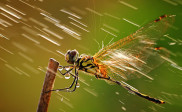7 Tips and Tricks for Better Photo Composition
There are as many ways to take a photo as there are photographers. But, in order for a photo to be pleasing to the eye and for its message to be channeled clearly, it must be composed in a correct way. Although there aren’t any strict rules about how a composition should be, there are several composition techniques which happen to be valuable in most cases. The following are 7 tips and tricks which will help you in making better compositions.
– Simplify:

Photo by Niklas Plessing
This is one of the most fundamental rules of composition. The simpler the composition, the more impact your photo will have. By simple, I don’t mean devoid of message and meaning. The simplicity is only on the level of composition and the arrangement of elements within a frame. A simple composition will have the main subject without any distracting elements around it. In order to achieve the simplest compositions, always, think of what you exactly want to photograph and try to make that element dominant, while getting rid of anything not relevant to your photo.
– Lead the eye:

Photo by Steve Webel
When composing, try to lead the viewer’s eyes towards the subject. Don’t let it wonder around the frame freely. In order to achieve this, you can use different types of lines in your composition, like diagonal lines and converging lines which can easily direct the attention towards an element. Also, curves and circular shapes can be very helpful in leading the eye throughout the frame and most important, in keeping it inside.
– Work on perfecting the background:

Photo by Gregory Bastien
Many photographers forget that the background can determine the impact of a photograph more than the subject. Having an interesting subject doesn’t mean you will get great results. The more you put into perfecting your background, the more chances you will have in creating an amazing shot. So, no matter the subject you are shooting, you need to pay close attention to what’s in your background, to get rid of any distracting elements or to include an interesting pattern, or a strong line. This applies in any type of photos. If you are shooting portraits, you need to blur the background to make the person you are photographing standout, and if you are an urban or street photographer, you should look for the best setting for your photo, perfect your composition and then wait for your subject. Whether, you are blurring the background or including it in the shot, you must compose in a way to make it in harmony with your subject and devoid of any distracting elements.
-leave some empty space around the subject:

Photo by Yassine Hakimi
Some times, a good photograph is ruined by the fact that it lacks “some air”. The subject is very often placed in the middle of the photo which leaves a small space on the four sides of a picture. In this case, the rule of thirds can be really helpful. By placing the subject on one of the intersecting lines, you leave enough space for the photo to breath. For instance, in the case of a portrait, it’s a good idea to leave some space in the direction of the eyes of the subject. Or, in case you are shooting a moving subject, it’s better to leave some space in front of it.
-A frame within the frame:

Photo by Robysaltori
This is an old composition technique; and it still works for a big variety of subjects. By framing your subject with elements from the setting, you will force the viewer’s eyes towards the subject. You are telling the viewer exactly where to look, no need to wander until finding the point of interest.
-Take the high ground:

Photo by Svenwerk
Shooting from a high point of view can give an interesting effect to your photos. Since the human eye is not very accustomed to such an angle, it will be easily drawn to photos from a high angle. High angles can work for different sorts of photography. It’s especially efficient when taking landscape photos (aerial photography). The landscape is shown from an unusual point where the pattern, lines and shapes of the different elements are emphasized.
– Practice, even without a camera.
A good way to learn more about composition is to keep always taking photos, even without a camera. Your eyes and imagination are all what you need. You can refine your composition skills while walking on the street, riding a bus, or whatever you are doing. You just need to pay attention to the things around you and to try to figure out how they can be photographed. Find your subject, imagine how the background should be, compose your shot, keeping in mind simplification, lines and patterns. Then take a mental picture. You will find the process a lot easier once you use a camera.



